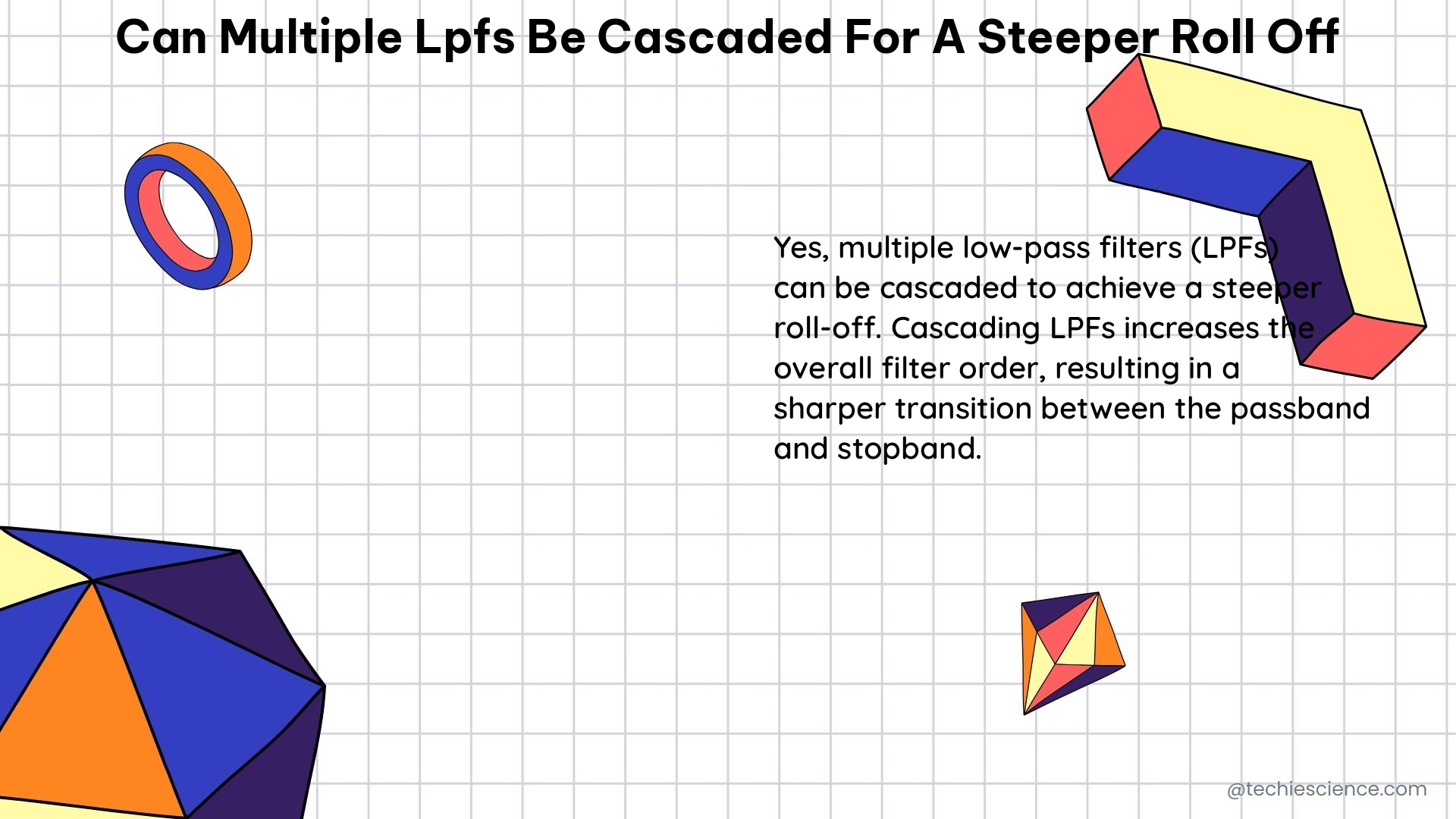Cascading multiple Low-Pass Filters (LPFs) can be a powerful technique to achieve a steeper roll-off, but it comes with its own set of trade-offs and considerations. In this comprehensive guide, we’ll dive deep into the theoretical and practical aspects of this approach, providing you with a detailed understanding of how it works and the factors you need to consider when implementing it.
Understanding Roll-Off and Filter Poles
The roll-off of a filter is a measure of how quickly the filter attenuates the signal as the frequency increases. It is typically expressed in decibels per decade (dB/decade) and is directly related to the number of poles in the filter. Each pole in a filter affects the phase response by -45 degrees per decade, and the group delay is equal to the derivative of the phase response with respect to frequency.
For an N-pole filter with purely real poles and purely imaginary zeros, the maximum group delay is given by:
T_D;LPF;max (ω) = N/2
This relationship between the number of poles, phase response, and group delay is crucial when considering the cascading of multiple LPFs.
Cascading Multiple LPFs: Theoretical Approach

In theory, cascading N identical LPFs would result in an overall filter with a roll-off of N times the roll-off of a single LPF. For example, if you have a single LPF with a roll-off of 20 dB/decade and you cascade two identical LPFs, the overall filter would have a roll-off of 40 dB/decade.
This is because each LPF contributes its own roll-off, and when cascaded, the individual roll-offs are multiplied. The overall cutoff frequency of the cascaded filter would also be approximately the same as the cutoff frequency of a single LPF.
Practical Considerations
While the theoretical approach seems straightforward, there are several practical limitations and trade-offs to consider when cascading multiple LPFs:
-
Increased Filter Order: Cascading multiple LPFs increases the overall filter order, which can lead to a more complex filter design and higher implementation costs.
-
Increased Group Delay: As the number of cascaded LPFs increases, the group delay of the overall filter also increases. This can result in phase distortion and signal dispersion, which can be particularly problematic in applications where phase distortion needs to be minimized, such as in communication systems.
-
Sensitivity to Component Variations: Cascading multiple LPFs can make the overall filter more sensitive to component variations, such as changes in capacitor and resistor values. This can affect the filter’s performance and stability.
-
Increased Noise and Distortion: Cascading multiple LPFs can also increase the overall noise and distortion of the system, as each stage contributes its own noise and distortion.
To quantify the effect of cascading multiple LPFs, let’s consider an example:
Suppose we have a single LPF with a cutoff frequency of 100 Hz and a roll-off of 20 dB/decade. If we cascade two identical LPFs, the overall filter will have a cutoff frequency of approximately 100 Hz and a roll-off of 40 dB/decade. However, the group delay of the overall filter will also be increased, as shown by the following equation:
T_D;total(ω) = 2 * T_D(ω) = 2 * 0.5/ω = 1/ω
As we can see, the group delay of the overall filter is twice that of a single LPF, which can lead to phase distortion and signal dispersion.
Alternatives and Optimization Strategies
To address the limitations of cascading multiple LPFs, there are several alternative approaches and optimization strategies you can consider:
-
Higher-Order Filters: Instead of cascading multiple LPFs, you can use a single higher-order filter, such as a Butterworth or Chebyshev filter, to achieve a steeper roll-off without the increased group delay.
-
Hybrid Filtering Approaches: Combining different filter types, such as LPFs and band-pass filters, can help optimize the trade-off between roll-off, group delay, and other performance metrics.
-
Digital Signal Processing (DSP) Techniques: Implementing filters using DSP algorithms can provide more flexibility and control over the filter characteristics, allowing for better optimization of the trade-offs.
-
Adaptive Filtering: Employing adaptive filtering techniques can help compensate for changes in the system and maintain the desired filter performance.
-
Careful Component Selection: Selecting high-quality, low-tolerance components can help mitigate the effects of component variations and improve the overall stability and performance of the cascaded LPF system.
Conclusion
Cascading multiple Low-Pass Filters can be a useful technique to achieve a steeper roll-off, but it comes with its own set of trade-offs and considerations. By understanding the theoretical and practical aspects of this approach, as well as the available alternatives and optimization strategies, you can make informed decisions and design effective filter systems that meet your specific requirements.
Remember, the choice of filter design ultimately depends on the specific needs of your application, so it’s essential to carefully evaluate the trade-offs and choose the most appropriate solution.
References
- Electronic Warfare and Radar Systems Engineering Handbook – DTIC
- RF and mm-wave blocker-tolerant reconfigurable receiver front-ends – Digitallibrary.usc.edu
- Taking the Mystery out of the Infamous Formula, “SNR=6.02N + 1.76” – Qtwork.tudelft.nl

The lambdageeks.com Core SME Team is a group of experienced subject matter experts from diverse scientific and technical fields including Physics, Chemistry, Technology,Electronics & Electrical Engineering, Automotive, Mechanical Engineering. Our team collaborates to create high-quality, well-researched articles on a wide range of science and technology topics for the lambdageeks.com website.
All Our Senior SME are having more than 7 Years of experience in the respective fields . They are either Working Industry Professionals or assocaited With different Universities. Refer Our Authors Page to get to know About our Core SMEs.